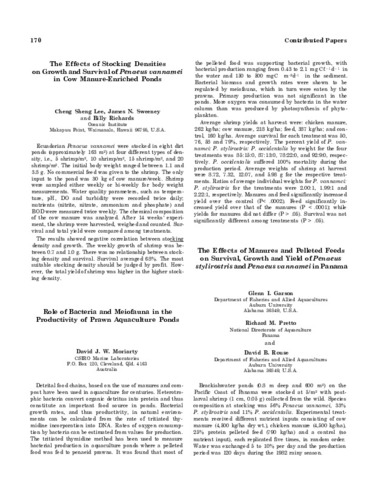Role of bacteria and meiofauna in the productivity of prawn aquaculture ponds
Share
Abstract
Detrital food chains, based on the use of manures and compost have been used in aquaculture for centuries. Heterotrophic bacteria convert organic detritus into protein and thus constitute an important food source in ponds. Bacterial growth rates, and thus productivity, in natural environments can be calculated from the rate of tritiated thymidine incorporation into DNA. Rates of oxygen consumption by bacteria can be estimated from values for production. The tritiated thymidine method has been used to measure bacterial production in aquaculture ponds where a pelleted food was fed to penaeid prawns. It was found that most of the pelleted food was supporting bacterial growth, with bacterial production ranging from 0.43 to 2.1 mgCℓ–1d–1 in the water and 150 to 500 mgC m–2d–1 in the sediment. Bacterial biomass and growth rates were shown to be regulated by meiofauna, which in turn were eaten by the prawns. Primary production was not significant in the ponds. More oxygen was consumed by bacteria in the water column than was produced by photosynthesis of phytoplankton.
Average shrimp yields at harvest were: chicken manure, 262 kg/ha; cow manure, 218 kg/ha; feed, 387 kg/ha; and control, 160 kg/ha. Average survival for each treatment was 50, 76, 58 and 79%, respectively. The percent yield of P. vannamei: P. stylirostris: P. occidentalis by weight for the four treatments was 85:15:0, 87:13:0, 78:22:0, and 92:9:0, respectively. P. occidentalis suffered 100% mortality during the production period. Average weights of shrimp at harvest were 8.72, 7.32, 12.07, and 5.98 g for the respective treatments. Ratios of average individual weights for P. vannamei: P. stylirostris for the treatments were 2.00:1, 1.99:1 and 2.22:1, respectively. Manures and feed significantly increased yield over the control (P< .0002). Feed significantly increased yield over that of the manures (P < .0001); while yields for manures did not differ (P > .05). Survival was not significantly different among treatments (P > .05).
Description
Abstract only.
Suggested Citation
Moriarty, D. J. W. (1985). Role of bacteria and meiofauna in the productivity of prawn aquaculture ponds (Abstract only). In Taki Y., Primavera J.H. and Llobrera J.A. (Eds.). Proceedings of the First International Conference on the Culture of Penaeid Prawns/Shrimps, 4-7 December 1984, Iloilo City, Philippines (p. 170). Iloilo City, Philippines: Aquaculture Department, Southeast Asian Fisheries Development Center.

